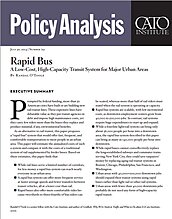Prompted by federal funding, more than 30 American cities have built or are building new rail transit lines. These expensive lines have debatable value as they put transit agencies in debt and impose high maintenance costs, yet they carry few riders more than the buses they replace and produce minimal, if any, environmental benefits. As an alternative to rail transit, this paper proposes a “rapid bus” system that would offer fast, frequent, and comfortable transportation to most people in an urban area. This paper will estimate the annualized costs of such a system and compare it with the costs of a traditional system of rail supplemented by feeder buses. Based on these estimates, this paper finds that
- While rail lines serve a limited number of corridors, for less money a rapid bus system can reach nearly everyone in an urban area.
- A rapid bus system can offer more frequent service at faster average speeds and fewer transfers between transit vehicles, all at a lower cost than rail.
- Rapid buses also offer more comfortable rides because two-thirds to three-fourths of bus riders can be seated, whereas more than half of rail riders must stand when the rail system is operating at capacity.
- Rapid bus systems are scalable, with low incremental costs, as downtown employment centers grow from 40,000 to 500,000 jobs. In contrast, rail systems require huge expenditures to start up and expand.
- While a four-line light-rail system can bring only about 36,000 people per hour into a downtown area, the rapid bus system described in this paper can bring as many as 140,000 people per hour into downtown.
- While rapid buses cannot cost-effectively replace the long-established subways and commuter trains serving New York City, they could save taxpayers’ money by replacing aging rail transit systems in Boston, Chicago, Philadelphia, San Francisco, and Washington.
- Urban areas with 40,000–200,000 downtown jobs should expand their transit systems using rapid buses rather than light rail or other rail systems.
- Urban areas with fewer than 40,000 downtown jobs probably do not need any form of high-capacity rapid transit.

